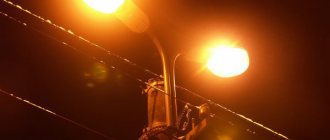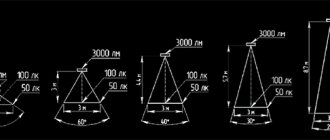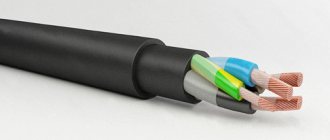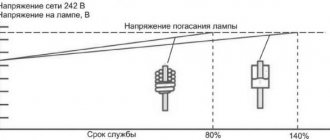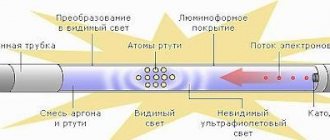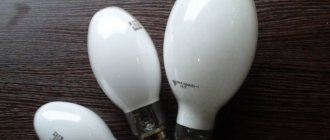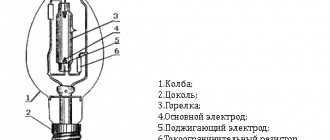Design
The design includes the following elements:
- glass container;
- threaded base;
- mercury-quartz burner filled with argon. Additionally, a drop of mercury is added;
- main cathodes;
- additional electrodes;
- additional carbon resistor.
Helpful information! The purpose of the additional electrodes is to facilitate lighting of the lamp. They are also responsible for stable operation.
The elements are discussed in more detail below:
- base It receives electricity from the network as a result of contact of the current-carrying parts of the lamp with the contacts of the lamp socket. As a result, electricity is transferred to the burner electrodes;
- quartz burner. It looks like a flask with two electrodes on each side (two are main, two are additional). The burner is filled with argon and a drop of mercury;
- glass flask. This is the outer part of the light bulb. Inside there is a burner with connected electrical conductors coming from the contact base. To pump nitrogen into the flask, all the air is first pumped out of it.
You may be interested in The problem of light bulbs burning out, how to fix it
The first models of DRL lamps had only two electrodes. Such lamps were more difficult to light - an additional starting device was required. The modern, throttle version is equipped with four electrodes.
Device
Alternative lighting sources
An energy-saving LED lamp is an excellent analogue to other lighting sources, including DRL; if you buy it, you can significantly save on electricity. Replacing street lighting will pay for itself after three years of operation, even taking into account the refurbishment work.
Many well-known foreign and Russian companies (for example, Lisma) are engaged in the production of these lighting devices. Currently, the price of these devices is slightly higher than the cost of a DRL lamp, but in the near future this problem will be eliminated, which will make LED lighting sources more accessible in Moscow, St. Petersburg, as well as in cities such as Saransk or Yekaterinburg.
Source
Scope of application
DRL lamps are used as a source of artificial lighting. The following objects are illuminated with gas discharge devices:
- highways and streets;
- parks and squares;
- production workshops, warehouses, parking lots;
- greenhouses, conservatories and similar places where vegetables are grown.
with DRLs characterized by a powerful luminous flux. At the same time, their color rendering is poor, so they are not used for lighting residential premises.
Exploitation
Comparison of DRL light bulbs with analogues
Discharge lamps are often compared with each other and with more profitable LEDs. The closest analogues of DRL are three types of illuminators: DRI, DRI and DNAT. Let's try to identify the features and competitive advantages of different light bulbs.
DRV. A mercury-tungsten arc lamp is very similar in design and operating principle to a DRL. Structurally, inside the flask there is a mercury discharge torch and a tungsten spiral. The last element limits the current for the burner, which means that additional ballasts are not needed.
The main differences between mercury-tungsten lamps and DRLs:
- They consume more electricity - the luminous flux of DRV 250 is no more than 5500 Lm;
- estimated operating time – 3000 hours;
- lights up within 1 minute.
DRI. Mercury arc lamps with emitting additives: indium, sodium, thalium halide, etc. Metal components increase the light output of devices to 75-90 Lm/W.
An additional advantage of metal halide mercury lamps is improved color rendering. To operate DRI, like DRL, they require connection via a choke
DNAT. Sodium arc lamps boast the highest light output and longest operating life among discharge illuminators. The performance of sodium light bulbs does not decrease as noticeably over time as DRL lamps.
Characteristics of DNAT:
- maximum light output – 125 Lm/W;
- operability – within 20 thousand hours;
- relative stability of parameters;
- wide range of operating temperatures;
- reaching maximum illumination in 5-7 minutes.
Disadvantages of sodium light sources: significant pulsation and low color rendering coefficient, Ra=25. The emission spectrum is dominated by red and yellow colors.
Discharge lamps are confidently giving way to LED options. LED devices are superior to their predecessors in all technical and operational parameters.
The undeniable advantages of LEDs: environmental friendliness, minimal pulsation, service life, instant switching, excellent color reproduction and contrast. In addition to excellent performance characteristics, diode devices have temperature and mechanical resistance.
The efficiency of LED lamps is unrivaled, operating efficiency reaches 95-98%. The main factor somewhat constraining the re-equipment of lamps is the high price of LED lamps
Life time
According to the manufacturers, such a light source is capable of burning for at least 12,000 hours. Here everything depends on such a characteristic as power - the more powerful the lamp, the longer it lasts.
Popular models and how many hours of service they are designed for:
- DRL 125 - 12000 hours;
- 250 - 12000 hours;
- 400 - 15000 hours;
- 700 - 20000 hours.
Note! In practice, the numbers may be different. The fact is that electrodes, like the phosphor, can fail faster.
As a rule, light bulbs cannot be repaired; they are easier to replace, since a worn-out product shines 50% worse.
Products are designed for at least 12,000 operating hours
There are several varieties of DRL (meaning mercury arc lamp), which are applicable both in everyday life and in industrial conditions. Products are classified by power, with the most popular models being 250 and 500 W. Using them, street lighting systems are still being created. Mercury devices are good due to their accessibility and powerful luminous flux. However, more innovative samples are appearing, safer and with better glow quality.
Operating principle of the DRL lamp
The burner of the product is made of transparent, chemically resistant, refractory material - quartz glass or special ceramics. It is filled with a precisely measured dose of inert gas and a drop of metallic mercury. The luminous body in the structure is a column of arc electric discharge.
The principle of operation inherent in the DRL lamp looks like this. When electricity is supplied to the product, a glow discharge is formed between the main and ignition electrodes. The elements are located so close to each other that they provide a lower breakdown voltage. A glow discharge almost instantly becomes an arc discharge. The electrical and luminous qualities of the lamp become stable 10 - 15 minutes after energy is supplied. During this period, the current exceeds the rated values (the ballast is used for limitation). The starting mode largely depends on the ambient temperature - in cold weather the light bulb takes longer to “start”.
It is in the burner that all the action takes place
As a result of the electrical discharge in the burner, blue and violet radiation, including UV (ultraviolet) radiation, becomes visible. They provoke the glow of the phosphor located on the inner walls of the flask. The burner shines with white-green light, the phosphor - reddish. The shades are mixed and the result is a bright color close to white.
If the voltage fluctuates in the electrical network, this is reflected in the luminous flux. Permissible voltage deviations are from 10 to 15% (in this case, the luminous flux will fluctuate by 25 - 30%). If the supply voltage drops to 80% of normal, the product simply will not light up. If it was on fire before, it will go out.
DRLs get very hot during operation. Because of this feature, it is necessary to carefully consider the design: use heat-resistant wires and high-quality contacts on the sockets. As the lamp heats up, the pressure in its burner increases, and with it the breakdown voltage. That is, the network voltage may not be enough to turn it on again. To restart the product, it needs time to cool down. This is the main drawback of DRLs - power surges simply extinguish them, and turning them on again requires a pause.
Additional Information! If the surrounding air is warm, the product will quickly reach the maximum light emission mode.
You might be interested in: Features of electronic ballast
Advantages and disadvantages
DRL sources have long been used for street and indoor lighting. During this time, users managed to highlight the advantages and disadvantages that determine their choice:
Advantages:
- good light output;
- high power;
- relatively small body size;
- low price compared to LED;
- economical energy consumption;
- most products are capable of operating for 12,000 hours (the figure depends on the quality of the components used).
There are also disadvantages that are important to consider:
- inside the flasks there are harmful mercury vapors that can cause poisoning if leaked;
- It takes some time from switching on to reaching the rated power;
- a preheated lamp cannot be turned on until it cools down (about 15 minutes);
- sensitive to voltage surges (a 15% deviation will cause a 30% change in brightness);
- equipment does not work well at low temperatures;
- during operation there is a pulsation of light;
- low color rendering;
- the elements become very hot;
- in the circuit you need to use specialized heat-resistant components (wires, cartridges, etc.);
- the arc element requires ballasts;
- sometimes the switched-on element makes an unpleasant sound;
- in the room where the lamps operate, ventilation is required to ventilate ozone;
- Over time, the phosphor loses its properties, which leads to a weakening of the luminous flux and a change in the spectrum.
Most of the disadvantages are inherent only in cheap DRLs from dubious manufacturers and are insignificant when a powerful lighting source is needed.
Design and principle of operation of DRL
To coordinate the technical characteristics with the power source, ballasts are used in all types of mercury lamps, allowing you to connect a DRL lamp. Most lighting devices are started by a choke, which is connected in series with the light bulb.
A classic DRL lamp consists of main electrodes, ignition or additional electrodes, lead-in parts of the electrodes, special gas, posistors and mercury. Argon is used as a gas, which produces initial ionization and contributes to the formation of an arc discharge. Argon is also called a buffer gas. Using posistors, the current of the igniting electrodes is limited. Mercury is used to change the potential during discharge.
The main functional parts of a conventional DRL
- A base that directly receives electricity from the network. Its contacts are point and threaded, connected to the contacts of the cartridge. Thus, alternating current is supplied to the lamp electrodes.
- The quartz burner is the main part. It is made in the form of a flask with four electrodes located on the sides, including two of them - the main ones, and the other two - additional ones. The space inside the burner is filled with argon to prevent heat transfer, as well as a small amount of mercury.
- The glass bulb is the outer part. It houses a quartz burner inside, to which conductors are connected from the base. Instead of air, nitrogen is pumped into the flask. The inside of the flask is coated with a phosphor.
The operating principle of DRL is quite simple. Power is supplied from mains voltage. After the DRL lamp has been connected, the electric current begins to reach the gap between both pairs of electrodes located at opposite ends of the lamp. A small distance between them promotes rapid ionization of the gas. First, the gas is ionized between the igniting electrodes, then the current flows to the main electrodes and at the end of this process the lamp begins to emit light.
The lamp begins to glow fully after approximately 7-10 minutes. This period of time is required to heat up the mercury located in the form of a deposit or clot on the inner walls of the flask. During operation, the service life of the lamps gradually decreases, and the period required for full activation increases.
The burner is made of transparent material - quartz glass, filled with inert gases in strictly defined doses. Mercury introduced into the burner may have the form of a small ball, and also settles on the walls and electrodes in the form of plaque. The light source is an electric arc discharge.
The DRL lamp circuit is included in the general connection circuit via a choke. The choke brand must match the lamp power. The main purpose of the inductor is to limit the current flowing to the light bulb. If there is no choke, the lamp will instantly burn out, since the external electric current is too large for it. Typically, a capacitor is also added to the circuit, which affects the reactive power at startup, which allows you to save electricity almost twice.
We advise you to study - Organization and types of repair of electrical machines
The greatest glow occurs after approximately 6-7 minutes. This time is necessary to transform the mercury into a gaseous state, which improves the discharge between the electrodes. After this, the lamp goes into normal operating mode with the highest light output. After turning off the light bulb, it should not be turned on until it has completely cooled down.
Design features
What are DRL 250 lamps made of? Their characteristics include the presence of the following components:
- Nickel plated base.
- A resistor that provides voltage limiting.
- Molybdenum foils.
- Framework.
- Glass flask (the luminomorphic coating is actually applied to it).
- Lead wire.
- Tungsten coated main electrode.
- Nitrogen, which acts as a filler for the outer flask.
- Compressed junction of a quartz light source. The quartz burner is the main working element of the lamp.
By the way, the first models of the lamps described had only two electrodes. However, such a device significantly worsened the process of turning on and warming up the lighting point, as a result of which the presence of an additional starting element called a high-voltage pulse-type breakdown of the burner gap was required. This version of the lamp was very quickly recognized as ineffective and was replaced with a four-electrode version equipped with a choke, without which the operation of such a lamp is simply physically impossible - it will simply burn out the moment it is turned on.
How can you start a DRL lamp without a choke?
To operate an arc lamp without an additional device, you can go in several directions:
- Use a light source with a special design (DRV type lamp). A feature of lamps that can operate without a choke is the presence of an additional tungsten filament, which acts as a starter. The parameters of the spiral are selected according to the characteristics of the burner.
- Starting a standard DRL lamp using a voltage pulse supplied by a capacitor.
- Ignition of a DRL lamp using a series connection of an incandescent lamp or other load.
Ignition of a lamp using a serial connection of a boiler is presented in a video filmed for the channel “A little bit of everything”.
Purchase of a special model DRL 250
Direct-on lamps are available in the product lines of a number of companies:
- TDM Electric (DRV series);
- Lisma, Iskra (DRV series);
- Philips (ML series);
- Osram (HWL series).
The characteristics of some direct-on lamps are shown in the table.
| Parameter | DRV 160 | DRV 750 |
| Power, W | 160 | 750 |
| Flow, Lm | 8000 | 37500 |
| Base | E27 | E40 |
| Resource, hours | 5000 | 5000 |
| Color temperature, K | 4000 | 4000 |
| Length, mm | 127 | 358 |
| Diameter, mm | 77 | 152 |
Operating principle of the DRV lamp:
- At the initial stage of ignition of the lamp, the spiral provides a voltage at the cathodes within 20 V.
- As the arc ignites, the voltage begins to increase, reaching up to 70 V. In parallel, the voltage on the coil decreases, causing a decrease in the glow. During operation, the spiral acts as an active ballast, which reduces the efficiency of the main burner. Therefore, there is a decrease in luminous flux with equal power consumption.
Advantages of DRV lamps:
- the ability to operate in 50 Hz alternating current networks with a voltage of 220-230 V without additional starting devices and supporting discharge combustion;
- Possibility of use instead of incandescent lamps;
- short time to reach full power mode (within 3-7 minutes).
Lamps have a number of disadvantages:
- reduced luminous efficiency (compared to conventional DRL lamps);
- resource reduced to 4000 hours, determined by the life of the tungsten filament.
Due to the disadvantages, DRV lamps are used in household lamps or in old industrial installations intended for the installation of powerful incandescent lamps. In this case, the devices improve illumination while reducing energy consumption.
Using a capacitor
When using lamps of the DRI type, starting is performed through an IZU - a special device that gives an ignition pulse. The composition includes a series-connected diode D and a resistance R, as well as a capacitor C. When voltage is applied to the capacitor, a charge is formed, which is supplied through the thyristor K to the primary winding of the transformer T. An increased voltage pulse is formed on the secondary winding, which ignites the discharge.
Capacitor ignition circuit
The use of elements allows you to reduce energy consumption by 50%. The connection diagram is identical; a dry-type capacitor is installed in parallel, designed to operate in circuits with a voltage of 250 V.
The capacitor capacity depends on the operating current of the chokes:
- 35 uF at current 3A;
- 45 microfarads at a current of 4.4A.
Using an incandescent lamp
To ignite the DRL, an incandescent lamp with a power equal to a gas-discharge lamp can be connected. It is possible to turn on the lamp by using a ballast resistor with the same power (for example, a boiler or an iron). Such methods do not provide stable operation and do not meet safety requirements, therefore they are not recommended for use.
Ignition of DRL 250 using an incandescent lamp with a power of 500 watts is demonstrated by the author Andrey Ivanchuk.
Design and principle of operation
A mercury gas discharge lamp, as its name suggests, is an electric light source that uses a gas discharge in mercury vapor to generate optical radiation. However, the adjective “luminescent” appears in the same name. This is due to the fact that to correct the color of the flux, the DRL lamp, in addition to the light from the gas discharge itself, uses the radiation of a phosphor that glows under its influence, which coats the inner surface of the lamp bulb. This makes the spectrum more uniform and wider and, as a result, improves color rendition.
It is known that for a discharge to occur in a gas, a high voltage must be applied between two electrodes, much greater than the standard 220 V. When a discharge already exists, it can be maintained at mains voltage. However, the smaller the distance between the electrodes, the less voltage is required to ignite the discharge. However, a small luminous area will not provide sufficient radiation power.
Therefore, in the first DRL lamps, the discharge was created using an external source of high voltage pulses, which pierced the working space between the electrodes when the lamp was turned on, and then the generator was turned off. Today, such a scheme has been returned to in sodium and metal halide gas-discharge lamps. However, at the time of the advent of mercury light sources (1960-70), such electronic devices were not reliable enough, so engineers had to look for another solution. Here we remembered the possibility of igniting a discharge using mains voltage at a small distance between the electrodes.
Since the 1970s, two additional ignition electrodes have been introduced into the design of mercury lamps, which are located very close to the main ones and are connected to opposite main electrodes through current-limiting resistors. Thus, when the lamp is turned on, two small glow discharges initially appear at each end of the burner, which gradually heat the entire volume of gas and ignite the main arc of the discharge (initially, this discharge is also glowing, but quickly turns into an arc). That is why the DRL’s paws do not immediately begin to glow brightly and for the first few minutes they “smolder” barely noticeably. In this case, the duration of the start-up mode strongly depends on the ambient temperature - the lower it is, the longer the lamp will warm up. A steady arc discharge between the main electrodes causes operating current to flow through the lamp, and small discharges no longer participate in the lamp combustion process.
Structurally, the burner with four electrodes is designed in the form of an internal flask made of quartz glass or special transparent ceramics, filled with an inert gas argon with the addition of metallic mercury. When the lamp is turned off and not warmed up, the mercury is inside the burner in the form of a separate small ball, or settles on the walls of the flask and electrodes in the form of a deposit. The material of the burner flask is very refractory and chemically resistant, so it can withstand the conditions necessary for a discharge to occur. The burner is placed inside an outer large flask made of ordinary glass. Conductors made of thick nickel wire and limiting resistances welded to them are also located here.
An electrical discharge in mercury vapor creates radiation with a very uneven, intermittent spectrum. It contains seven spectral lines, three of which, and at the same time the most intense, lie in the ultraviolet range. It is under their influence that the phosphor applied to the inner walls of the large flask glows. The visible light from the discharge has a blue-green hue, while the phosphor glows a warmer, reddish light. The radiation from both emitting objects, mixing, gives a bright and even light, quite close to white.
Principle of operation
After turning on the light source in the electrical network, voltage is supplied to the current-carrying parts of the lamp located in the base. Through an electrical circuit, voltage is supplied to the electrodes mounted in the burner, as a result of which a glow discharge appears between them. This is due to the formation of additional free electrons and ions on their surface.
As electrons and ions accumulate, the internal space of the gas discharge tube heats up, and the mercury begins to evaporate. This ensures a discharge mode between the electrodes, moving from a smoldering state to an arc one.
As the amount of mercury vapor increases, the brightness of the arc discharge increases.
Under normal operating conditions, the time it takes for the light source to reach the stated technical parameters is 4.0–5.0 minutes.
Modifications of DRL and DVR are no different in appearance
Technical aspects
The most important indicators of a mercury light source with an e40 base are the design of the internal part of the device, the shape of the bulb, and the dimensions of the threaded base. The economic effect of the device may differ in operating conditions. The gas-discharge soffit from the Lisma brand for street lighting, which does not create a flickering effect in the event of voltage surges in the electrical network, does not require a special device for igniting the arc. At a power of 500 W, a luminous flux of 4 - 5 thousand lm is created.
- Name - DRV lamp;
- Type - mercury;
- Power - 500 V;
- Shape - ellipse;
- Manufacturer - ;
- Purpose - street;
- The flask coating is matte;
- Base - e40.
When marking energy-saving appliances, digital and letter values are used to indicate the power and type of product. It is not difficult to decipher these meanings. Examples:
- DRL 250 - arc mercury phosphor lamp with a power of 250 V;
- DRV 160 is a mercury-tungsten arc lamp with a power of 160 V.
What is a throttle for?
The choke for DRL lamps is used for starting; there are different types of lighting devices on the market in which it is used:
- Fluorescent and ultraviolet lamps.
Ultraviolet lamp Various types of mercury arc lighting devices: DRT, DRL, DRIZ, DRSh, DRI.
Arc mercury lamps Arc sodium lamps: DNaMT, DNaS, DNaT. Arc sodium lamp All lighting devices have differences in the principle of obtaining light flux, there are other differences:
- different materials are used in their design;
- differ in the presence of chemical elements;
- inside the flasks there is pressure according to the own parameters of each lighting device;
- they differ in power and brightness of the light flux.
These types of lamps are united by the variable value of the starting current and resistance during the start-up process and further operation.
In order to limit the amount of operating current, different types of ballast are used in lighting devices of this type: electronic ballasts, ballasts and ballasts, which are inductor coils (chokes). At the moment of startup, each device of this type has a high resistance value; when the lighting device is ignited, a process of electrical breakdown occurs in the inert gas environment with which the lamp is filled (mercury or sodium vapor), and an arc discharge occurs.
During the process when the lamp is ignited, the ionized gas loses resistance from the arc discharge several tens of times, and for this reason the current increases and heat is released. If you do not limit the amount of current, it will instantly create a superheated gas environment, which will lead to breakdown of the lighting device and damage from the inside. To prevent this, a resistance (choke) is included in the lighting device circuit.
Physical parameters and connection diagram of the inductor
A DRL inductor connected in series has a reactance, the value of which depends on the inductor: one Henry passes one ampere of current when the voltage is one volt.
Throttle
The parameters of the inductor include:
- square of copper wire used;
- number of turns;
- what is the core and cross-sectional size of the magnetic circuit;
- what electromagnetic saturation.
The inductor has an active resistance, which is always taken into account when calculating the ballast for each type of lighting device of this type, taking into account its power; the overall dimensions of the inductor depend on this.
Let's consider a simple circuit for switching on the ballast, when the design of the DRL lamp provides (additional) electrodes for the process of occurrence of a glow discharge that turns into an electric arc.
DRL lamp connection diagram
In this case, inductance limits the amount of operating current in the lighting device.
Ballast for fluorescent lamps
Structurally, a fluorescent lighting device uses a ballast choke for starting; new types of this lighting device use electronic ballasts, this is an electronic type of ballast. The purpose of this device is to contain the increasing current value at one level, which maintains the required voltage on the electrodes inside the lighting fixture.
Connection diagram for DRL lamp via inductor
There are many objects where lighting devices with high luminous power are required. At the same time, they must be economical and have a long service life. DRL lamps fully comply with these requirements. The power of DRL lamps is in the range of 50-2000 W; their operation requires a single-phase network of 220 V and a frequency of 50 Hz.
The most important part of the DRL is the throttle, without which they simply cannot work. The fact is that during the startup process and subsequent operation, these lighting devices come under the influence of variable starting currents and resistances. Therefore, to limit the operating current, the DRL is connected through a choke, which is a heterogeneous ballast in the form of inductors. At the moment of startup they have high resistance. When the lamp is ignited in a gas environment, an electrical breakdown occurs, leading to the occurrence of an arc discharge.
In the process of igniting the lamp, the ionized gas under the action of an arc discharge loses its resistance many times. For this reason, the current increases with the simultaneous release of heat. If the magnitude of the current is not limited, a superheated gaseous environment will instantly arise under its action. Internal parts will be damaged and the lighting fixture will fail completely. To prevent negative consequences, a DRL lamp connection circuit is used together with a choke, which creates the necessary resistance.
Connecting the DRL lamp through a choke, connected in series with the lamp. Its reactance is closely related to the parameters of the inductor. That is, 1 henry of inductance is capable of passing 1 A of current at a voltage of 1 V. The main characteristics of the coil are the cross-sectional area of the copper conductor and the number of its turns, as well as the core material and the cross-section of the magnetic circuit. The magnitude of electromagnetic saturation is of great importance.
It should be taken into account that the inductor also has active resistance. This must be taken into account when calculating the ballast for each type of DRL light bulb, since the size of the inductor itself will depend on the power of the lamp. To more correctly connect the inductor to the DRL, you should consider the simplest circuit that ensures the appearance of a glow discharge and its further transition into an electric arc. This connection makes it possible, using the inductance of the choke, to limit the operating current in the lamp to the desired value. In this case, long-term stable operation of the lamp is guaranteed, without any failures.
This scheme for switching on a DRL lamp is considered the simplest. It consists of the lamp itself and the choke, connected in series to each other. The resulting circuit is connected to a 220 V electrical network with a standard frequency of 50 Hz. Thus, DRL lamps can be used at home without any problems. The choke for DRL lamps in this circuit performs the functions of a stabilizer and work corrector. Its use makes it possible to accurately answer the question of why DRL lamps blink without a choke, since it is this device that provides even and stable light. Without it, it is impossible to connect normally and start the workflow.
How LDS is structured and works
Structurally, the device is a sealed flask filled with inert gas and mercury vapor. The inner surface of the flask is covered with a phosphor, and electrodes are soldered into its ends. When voltage is applied to the electrodes, a glow discharge occurs between them, creating invisible ultraviolet radiation. This radiation affects the phosphor, causing it to glow.
Fluorescent lamp circuit
All these are LDS, working on the same principle.
For normal operation of a fluorescent lamp, two conditions must be met:
- Provide initial breakdown of the interelectrode gap (start).
- Stabilize the current through the light bulb so that the glow discharge does not turn into an arc discharge (work).
Start the lamp
Under normal conditions, the supply voltage is not enough for electrical breakdown of the interelectrode gap, so starting an LDS can only be done with the help of additional measures - heating the electrodes to start thermionic emission or increasing the supply voltage to values sufficient to create a discharge.
Until recently, the first method was predominantly used, for which the electrodes were made (and are made) in the form of spirals, like those found in ordinary incandescent light bulbs. At the moment of switching on, voltage is applied to the spiral using automatic devices (starters), the electrodes heat up, ensuring the ignition of the lamp. After starting the system, the starter is turned off and does not participate in further operation.
Starters for starting LDS at various voltages
Later, circuit solutions began to appear that did not heat the electrodes, but supplied them with increased voltage. After breakdown of the interelectrode gap, the voltage automatically decreases to the nominal value, and the lamp goes into operating mode. In order for LDS to be used with any type of starting devices, all of them to this day are made with electrodes in the form of incandescent spirals, each having two terminals.
Maintaining operating mode
If the LDS is directly plugged into a socket, then the glow discharge that begins after ignition will immediately turn into an arc, since the ionized interelectrode gap has very low resistance. To avoid this situation, the current through the device is limited by special devices - ballasts. Ballasts are divided into two types:
- Electromagnetic (throttle).
- Electronic.
The operation of electromagnetic ballasts (EMGPA) is based on the principle of electromagnetic induction, and they themselves are chokes - coils wound on an open iron core. This design has an inductive resistance to alternating current, which is greater, the higher the inductance of the coil. Chokes vary in power and operating voltage, which must be equal to the power and voltage of the lamp used.
Electromagnetic chokes (ballasts) for LDS with a power of 58 (top) and 18 W.
Electronic ballasts (EPG) perform the same function as electromagnetic ones, but limit the current using an electronic circuit:
Electronic ballast for fluorescent lamp
Device types
There are different types of lamps that work in this way. Moreover, they are all used in the modern world. Let's look at them:
DRL is a mercury arc type fluorescent lamp. The description and principle of operation are given above. Powered by mercury vapor.
DRV - devices operating at high pressure. They have a tungsten filament that serves as a light source. It also limits the voltage of the electric current. Such devices do not require equipment that regulates the start. These are throttleless light bulbs.
Gas discharge lamp DRI 400-7 E40
DRLF. Lamps that enhance photosynthesis in various plant species. Used in greenhouse conditions. Useful for farmers and flower growers.
DRUFZ and DRUF are long-wave ultraviolet lamps.
DRT - ultraviolet tube illuminators.
HPS - tubular type bulbs. They contain not only mercury, but also sodium vapor. The color of the radiation ranges from golden-white to yellow-orange. They are launched using specialized equipment.
HPS lamp with two burners for increased service life
Advantages and negative qualities
What is good and what is bad about DRL 250 lamps? The characteristics of their development provide them with the following positive indicators:
- Very high light output compared to other lighting devices.
- No dependence on precipitation.
- An impressive service life, which can easily reach 20 thousand hours.
- The emission spectrum is very close to natural light.
- Small own dimensions.
The disadvantages of lamps are:
- Formation of ozone during operation.
- Quite a high price (such lamps are 5–7 times more expensive than a regular incandescent lamp).
- In some cases, tungsten analogues will have smaller dimensions than DRL.
- After several months of operation, the emitted light spectrum changes as the technical characteristics of the phosphor layer change.
- The presence of mercury forces users to dispose of lamps according to a special scheme, separately from other goods, things, and products.
- Switching on occurs with some delay, and it takes several minutes to achieve combustion at full power.
- The light from such lamps is of rather low quality.
- Very high flicker factor during operation.
- It is best to hang lamps at a height of at least four meters.
- Towards the end of its service life, the luminous flux of the device decreases significantly.
- The lamp can only operate on alternating current.
Technical characteristics of DRL lamps
The marking of mercury arc phosphor lamps implies the designation of their power. In other words, a DRL-250 light bulb will have a power of 250 watts, and a DRL-400 light bulb will have a power of 400 watts. Obviously, the technical characteristics of the DRL-250 lamp will differ from the similar characteristics of the DRL-400 lamp.
Throttle
The main technical parameters of the considered artificial light sources of the most common power (from 125 to 700 watts) can be summarized in the following table.
| Lamp | Power- ity, W | Starting current, A | Operating current, A | Voltage, V | Luminous flux, Lm | Service life, h |
| DRL-125 | 125 | 2,40 | 1,15 | 125 | 5900 | 12000 |
| DRL-250 | 250 | 4,50 | 2,13 | 130 | 13000 | 12000 |
| DRL-400 | 400 | 7,20 | 3,25 | 135 | 23500 | 15000 |
| DRL-700 | 700 | 12,00 | 5,40 | 140 | 40600 | 20000 |
As you can see, the luminous flux of a DRL-250 bulb is 13 thousand lumens, while a 200-watt incandescent bulb emits only 2500 lumens of light. Now you can judge that when we called the glow of arc mercury phosphor light sources very bright, we were in no way exaggerating.



